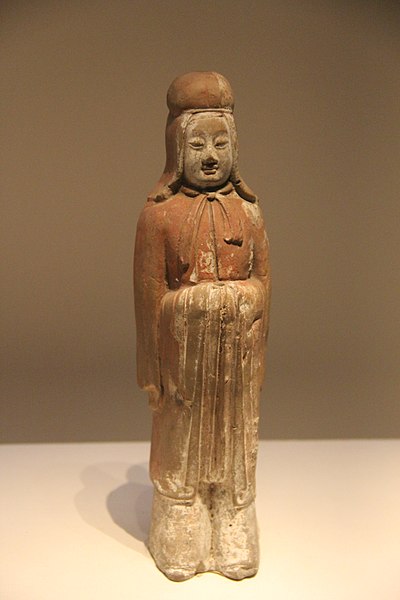Six Dynasties is a collective term for six Han Chinese-ruled Chinese dynasties that existed from the early 3rd century AD to the late 6th century AD, between the end of the Han dynasty and beginning of the Sui dynasty. The Six Dynasties period overlapped with the era of the Sixteen Kingdoms, a chaotic warring period in northern China after the collapse of the Western Jin dynasty. The term "Wei, Jin, Southern and Northern Dynasties" is also used by Chinese historians when referring to the historical period of the Six Dynasties, although both terms do not refer to the exact same dynasties.
Ewer, lidded tripod with handles, used for heating certain alcoholic drinks. Stoneware with pale green (celadon) glaze. Six Dynasties. Victoria and Albert Museum
Image: Tomb of Northern Qi Dynasty in Jiuyuangang, Xinzhou, Mural 02
The Jin dynasty or the Jin Empire, sometimes distinguished as the Sima Jin (司馬晉) or the Two Jins (兩晉), was an imperial dynasty in China that existed from 266 to 420. It was founded by Sima Yan, eldest son of Sima Zhao, who had previously been declared the King of Jin. There are two main divisions in the history of the dynasty. The Western Jin (266–316) was established as the successor to Cao Wei after Sima Yan usurped the throne from Cao Huan and took the title of Emperor Wu. The capital of the Western Jin was initially in Luoyang, though it later moved to Chang'an. In 280, after conquering Eastern Wu, the Western Jin ended the Three Kingdoms period and reunited China proper for the first time since the end of the Han dynasty.
Western Jin-era porcelain figurine
Yue ware with motif, 3rd century CE, Western Jin, Zhejiang.
Pottery tower, Western Jin, 265–317 CE.
Celadon lion-shaped bixie, Western Jin, 265–317 CE.






